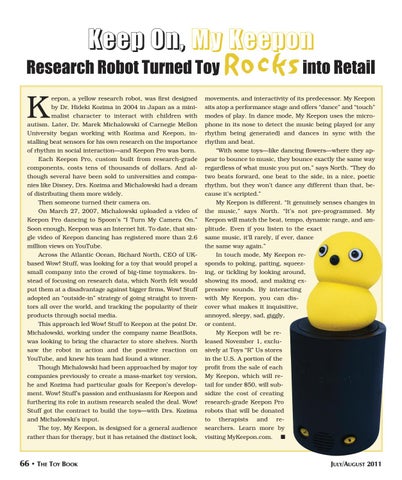Keep On, My Keepon Research Robot Turned Toy Rocks into Retail
K
eepon, a yellow research robot, was first designed by Dr. Hideki Kozima in 2004 in Japan as a minimalist character to interact with children with autism. Later, Dr. Marek Michalowski of Carnegie Mellon University began working with Kozima and Keepon, installing beat sensors for his own research on the importance of rhythm in social interaction—and Keepon Pro was born. Each Keepon Pro, custom built from research-grade components, costs tens of thousands of dollars. And although several have been sold to universities and companies like Disney, Drs. Kozima and Michalowski had a dream of distributing them more widely. Then someone turned their camera on. On March 27, 2007, Michalowski uploaded a video of Keepon Pro dancing to Spoon’s “I Turn My Camera On.” Soon enough, Keepon was an Internet hit. To date, that single video of Keepon dancing has registered more than 2.6 million views on YouTube. Across the Atlantic Ocean, Richard North, CEO of UKbased Wow! Stuff, was looking for a toy that would propel a small company into the crowd of big-time toymakers. Instead of focusing on research data, which North felt would put them at a disadvantage against bigger firms, Wow! Stuff adopted an “outside-in” strategy of going straight to inventors all over the world, and tracking the popularity of their products through social media. This approach led Wow! Stuff to Keepon at the point Dr. Michalowski, working under the company name BeatBots, was looking to bring the character to store shelves. North saw the robot in action and the positive reaction on YouTube, and knew his team had found a winner. Though Michalowski had been approached by major toy companies previously to create a mass-market toy version, he and Kozima had particular goals for Keepon’s development. Wow! Stuff’s passion and enthusiasm for Keepon and furthering its role in autism research sealed the deal. Wow! Stuff got the contract to build the toys—with Drs. Kozima and Michalowski’s input. The toy, My Keepon, is designed for a general audience rather than for therapy, but it has retained the distinct look,
66 • THE TOY BOOK
movements, and interactivity of its predecessor. My Keepon sits atop a performance stage and offers “dance” and “touch” modes of play. In dance mode, My Keepon uses the microphone in its nose to detect the music being played (or any rhythm being generated) and dances in sync with the rhythm and beat. “With some toys—like dancing flowers—where they appear to bounce to music, they bounce exactly the same way regardless of what music you put on,” says North. “They do two beats forward, one beat to the side, in a nice, poetic rhythm, but they won’t dance any different than that, because it’s scripted.” My Keepon is different. “It genuinely senses changes in the music,” says North. “It’s not pre-programmed. My Keepon will match the beat, tempo, dynamic range, and amplitude. Even if you listen to the exact same music, it’ll rarely, if ever, dance the same way again.” In touch mode, My Keepon responds to poking, patting, squeezing, or tickling by looking around, showing its mood, and making expressive sounds. By interacting with My Keepon, you can discover what makes it inquisitive, annoyed, sleepy, sad, giggly, or content. My Keepon will be released November 1, exclusively at Toys “R” Us stores in the U.S. A portion of the profit from the sale of each My Keepon, which will retail for under $50, will subsidize the cost of creating research-grade Keepon Pro robots that will be donated to therapists and researchers. Learn more by visiting MyKeepon.com. ■
JULY/AUGUST 2011
